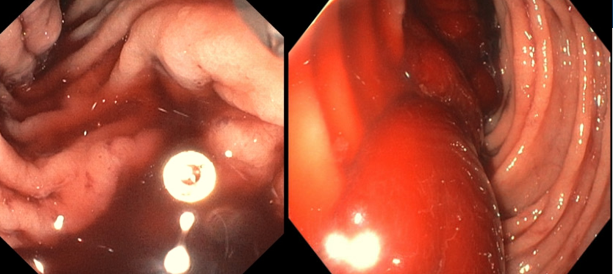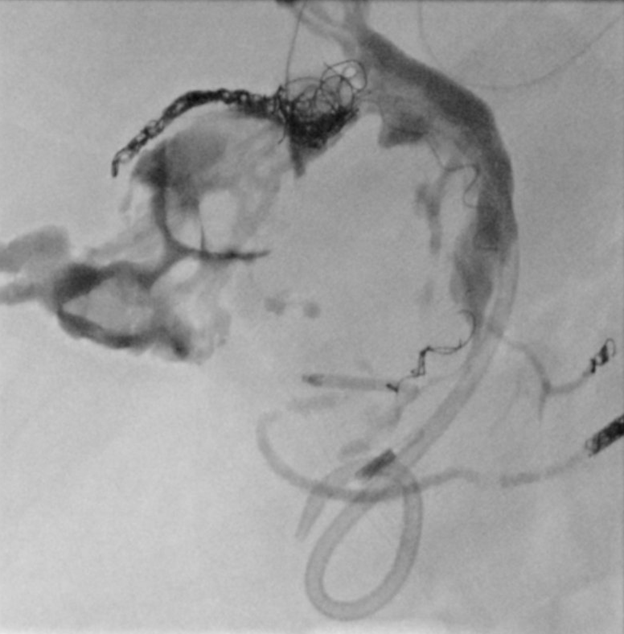Monday Poster Session
Category: Biliary/Pancreas
P2259 - A Rare Case of Haemobilia Due to Cystic Artery Pseudo-Aneurysm Coil Migration Through the Gallbladder Into the Common Bile Duct
Monday, October 27, 2025
10:30 AM - 4:00 PM PDT
Location: Exhibit Hall

Rama Nanah, MD (she/her/hers)
Charleston Area Medical Center
Charleston, WV
Presenting Author(s)
Rama Nanah, MD, Alaa Habash, MD, Nadeem Anwar, MD, Ebubekir Daglilar, MD
Charleston Area Medical Center, Charleston, WV
Introduction: Coil migration to other organs after pseudo-aneurysm arterial embolization is extremely rare, and only few cases have been reported previously. Most cases of migration have various levels of near-by organ inflammation, including chronic pancreatitis or cholecystitis. Obstruction, infection and bleeding can all occur depending on the site the coil migration.
Case Description/
Methods: 70-year-old female initially presented to the hospital as a transfer from outside facility with acute type B aortic dissection and incidental finding of cholecystitis with large gallstones on CT scan. A percutaneous cholecystostomy tube was placed after she was deemed poor surgical candidate. Hospital course further complicated by upper gastrointestinal bleeding and Esophagogastroduodenoscopy (EGD) revealed Dieulafoy's lesions in the second portion of the duodenum that two attempts of endoscopic hemostasis. Interventional radiology (IR) was consulted. During gastroduodenal artery (GDA) embolization, patient was found to have pseudo-aneurysm of the cystic artery, so coil and gel embolization were performed along with the two major branches of the GDA with percutaneous biliary drain placement. One month after initial presentation, patient returned to the hospital with bright red blood per rectum with Hgb of 6.5 g/dL.
Repeat EGD found active bleeding in the duodenum with blood clots and pigtail catheter protruding from the ampulla of Vater with bleeding around the catheter and blood in the biliary drain (Image 1). Angiography demonstrated residual cystic artery pseudoaneurysm with migration of part of the micro coil into the common bile duct (CBD) from the pseudo aneurysm through the gallbladder (Image 2). Repeat embolization of the cystic artery was performed with internal-external biliary catheter exchange and percutaneous removal of the micro coil through the gallbladder using a snare.
Discussion: This case highlights a challenging course of upper GI bleeding with Dieulafoy's lesion that was refractory to multiple endoscopic hemostasis that needed angioembolization. Unfortunately, rare complication of coil migration through the bile duct resulted in this case with further bleeding from haemobilia that was eventually controlled with repeat IR intervention with removal of coil and external/internal biliary drains and embolization of cystic artery.

Figure: EGD captured images from duodenum

Figure: Interventional Radiology images showing coil in the billiary tree
Disclosures:
Rama Nanah indicated no relevant financial relationships.
Alaa Habash indicated no relevant financial relationships.
Nadeem Anwar indicated no relevant financial relationships.
Ebubekir Daglilar indicated no relevant financial relationships.
Rama Nanah, MD, Alaa Habash, MD, Nadeem Anwar, MD, Ebubekir Daglilar, MD. P2259 - A Rare Case of Haemobilia Due to Cystic Artery Pseudo-Aneurysm Coil Migration Through the Gallbladder Into the Common Bile Duct, ACG 2025 Annual Scientific Meeting Abstracts. Phoenix, AZ: American College of Gastroenterology.
Charleston Area Medical Center, Charleston, WV
Introduction: Coil migration to other organs after pseudo-aneurysm arterial embolization is extremely rare, and only few cases have been reported previously. Most cases of migration have various levels of near-by organ inflammation, including chronic pancreatitis or cholecystitis. Obstruction, infection and bleeding can all occur depending on the site the coil migration.
Case Description/
Methods: 70-year-old female initially presented to the hospital as a transfer from outside facility with acute type B aortic dissection and incidental finding of cholecystitis with large gallstones on CT scan. A percutaneous cholecystostomy tube was placed after she was deemed poor surgical candidate. Hospital course further complicated by upper gastrointestinal bleeding and Esophagogastroduodenoscopy (EGD) revealed Dieulafoy's lesions in the second portion of the duodenum that two attempts of endoscopic hemostasis. Interventional radiology (IR) was consulted. During gastroduodenal artery (GDA) embolization, patient was found to have pseudo-aneurysm of the cystic artery, so coil and gel embolization were performed along with the two major branches of the GDA with percutaneous biliary drain placement. One month after initial presentation, patient returned to the hospital with bright red blood per rectum with Hgb of 6.5 g/dL.
Repeat EGD found active bleeding in the duodenum with blood clots and pigtail catheter protruding from the ampulla of Vater with bleeding around the catheter and blood in the biliary drain (Image 1). Angiography demonstrated residual cystic artery pseudoaneurysm with migration of part of the micro coil into the common bile duct (CBD) from the pseudo aneurysm through the gallbladder (Image 2). Repeat embolization of the cystic artery was performed with internal-external biliary catheter exchange and percutaneous removal of the micro coil through the gallbladder using a snare.
Discussion: This case highlights a challenging course of upper GI bleeding with Dieulafoy's lesion that was refractory to multiple endoscopic hemostasis that needed angioembolization. Unfortunately, rare complication of coil migration through the bile duct resulted in this case with further bleeding from haemobilia that was eventually controlled with repeat IR intervention with removal of coil and external/internal biliary drains and embolization of cystic artery.

Figure: EGD captured images from duodenum

Figure: Interventional Radiology images showing coil in the billiary tree
Disclosures:
Rama Nanah indicated no relevant financial relationships.
Alaa Habash indicated no relevant financial relationships.
Nadeem Anwar indicated no relevant financial relationships.
Ebubekir Daglilar indicated no relevant financial relationships.
Rama Nanah, MD, Alaa Habash, MD, Nadeem Anwar, MD, Ebubekir Daglilar, MD. P2259 - A Rare Case of Haemobilia Due to Cystic Artery Pseudo-Aneurysm Coil Migration Through the Gallbladder Into the Common Bile Duct, ACG 2025 Annual Scientific Meeting Abstracts. Phoenix, AZ: American College of Gastroenterology.
